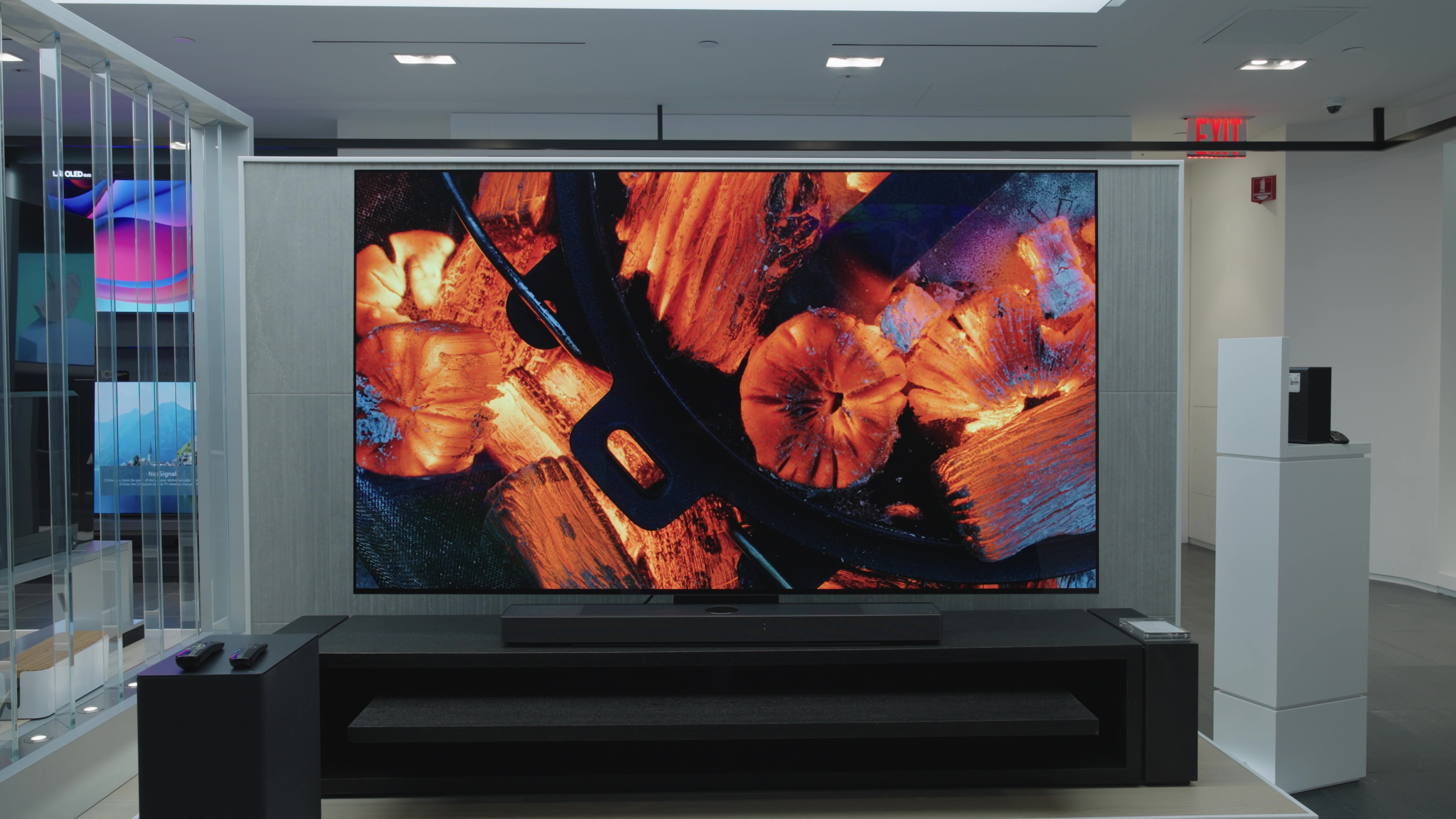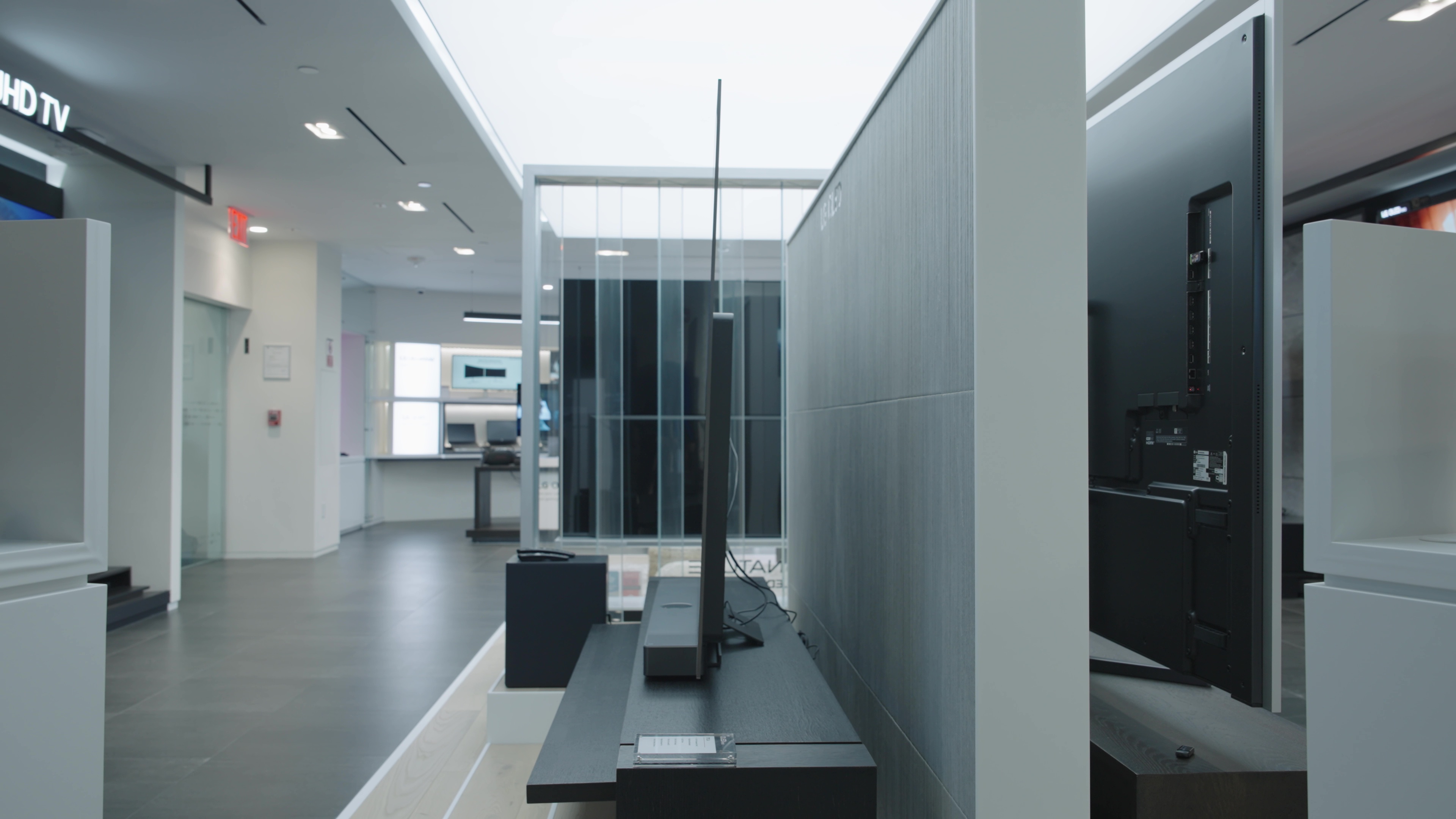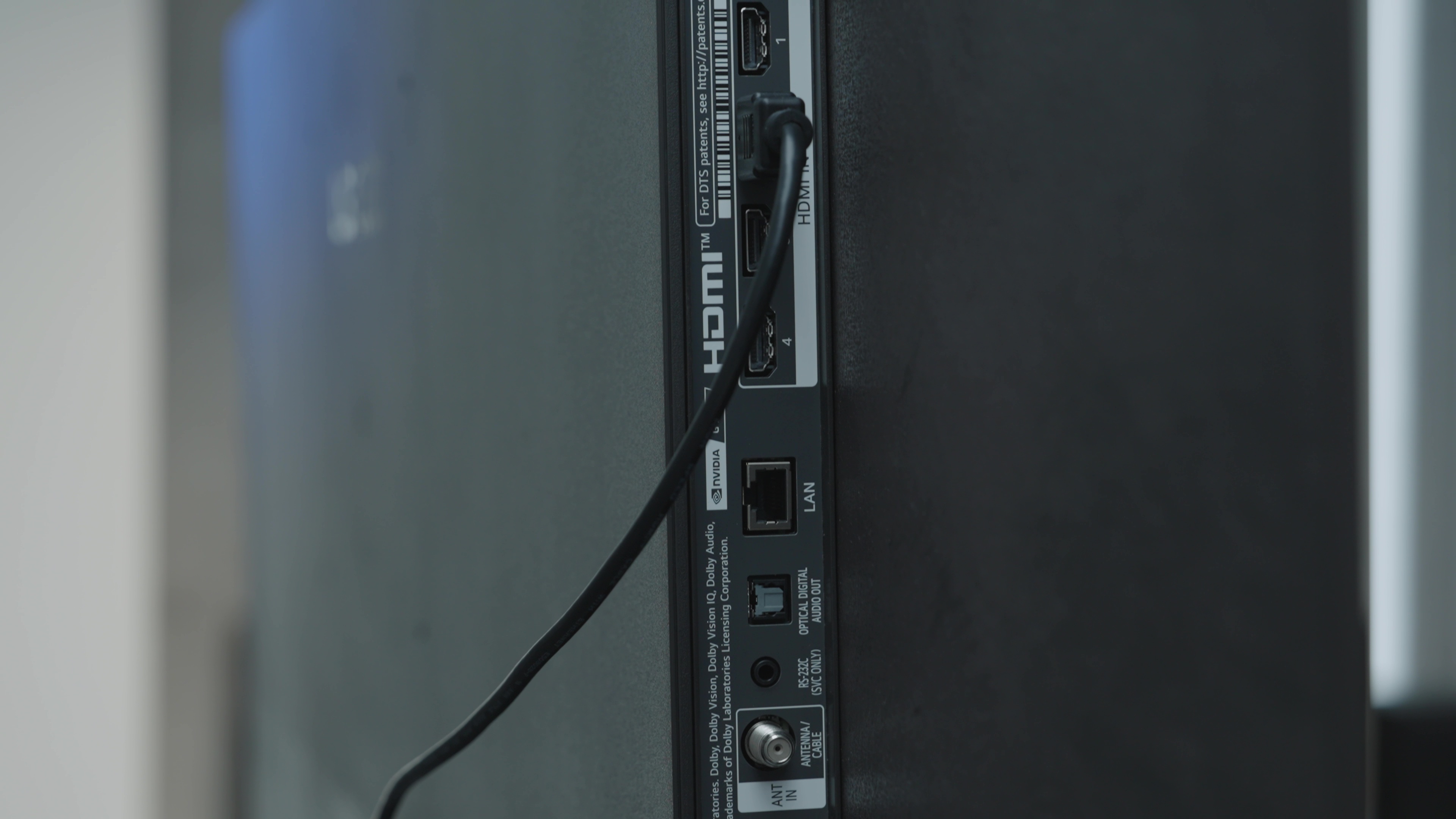
I just got an in-depth look at LG’s best 2024 TVs, and I have good news, better news, and one pleasant surprise that I think is going to make some of you very happy.
I visited LG at its U.S. headquarters in New Jersey to get a closer look at and more details on some of its most exciting products for 2024. I did a pretty deep dive on the LG G4 OLED, caught just a glimpse of the C4 OLED, was smacked upside the head by the flagship 4K QNED mini-LED TV, and had a one-on-one conversation with the head of LG’s webOS team and – well, let’s just say I may make a webOS fan out of some of you by the end of this article.
Before I go further, I didn’t get to take any measurements on this trip – nobody did. But I was able to compare the G4 against last year’s G3, and the Sony A95L and Samsung S95C were in the lineup as well.
LG G4 OLED
Let’s just get right to the G4 OLED, shall we? Because, folks, I’m impressed.
Let’s start by talking about how we won’t do much talking about brightness. Sure, LG was very proud to point out that the G4 was some percentage brighter than the entry-level B4. and it was careful to clarify that most of the brightness boost the G4 saw was going to be in HDR highlights, which we would expect.

But the best news about the new G4 is not new record-breaking brightness numbers. I know we like to get excited about that kind of thing – we’ve been conditioned to it as we’ve spent the last few years waiting for OLEDs to get bright enough to look great in bright rooms as well as dark rooms. But we’ve already achieved that milestone. The G3 was the big revolution we were waiting for when it came to brightness. Any brightness improvements to the G4 will be fairly incremental – and that’s just fine.
LG added a few new settings that I think will set the G4 OLED apart from all the other OLEDs.
But, like I said, the G4’s brightness is not the news. So, what is there to be excited about? Quite a bit, actually. This came as a really pleasant surprise because most of what I learned at this event was not covered at CES.
Looking back at the LG G3 OLED, I’d say there were seven little things that I hoped would be improved for the G4. I’m happy to say it looks like we got about 6.5 out of the seven. Plus, LG added a few new settings that I think will set the G4 OLED apart from all the other OLEDs that come out this year.
The first thing that’s improved is that the 55-inch and 65-inch LG G4 sizes now come with a stand – not a wall mount – included in the box. LG says it learned that most of the people buying the 55-inch and 65-inch models wanted a stand, not a no-gap wall mount, in the box. So, wish granted. You still get the no-gap wall mount in the box instead of a stand in the 77- and 83-inch models. The stand that comes with the 55 and 65 inchers holds the TV perfectly upright. No more lean-back like the G3.
- 3. LG G4 OLED
The second improvement is that the 83-inch G4 now has an MLA panel, so it’s capable of all the same brightness as the 55-inch, 65-,inch and 77-inch models — and then some — because it’s bigger.
The next improvement I saw was that, on the three samples I viewed, color shifting was improved. It used to be you could see magenta rings in large white areas. I didn’t see that this time. As for panel banding – well, I saw a tiny bit of it on the 83-inch model I viewed, but overall, the panels looked pretty clean.
Improvement four is that near-black chrominance overshoot appears to have been improved a bit. Now, we didn’t get to test this in-depth, but fellow YouTuber and ace calibrator Classy Tech Calibrations ran a couple of the scenes that I think should have triggered it, and it looked better on the G4 than the G3. Now, I don’t think this is a huge net benefit to most folks, but for super-picky nit nerds, it’s one more thing to be impressed by.

Next up is color brightness in LG’s game mode. Now, this wasn’t something I complained about much in my review because I’m not a huge gamer, and frankly, I thought the G3’s game mode looked pretty good. But, Classy Tech Calibrations claimed last year that the G3’s color brightness in HDR gaming was better in Filmmaker mode than it was in the Game mode. While we weren’t able to measure it, subjectively, color brightness in Game mode on the G4 was indistinguishable from Filmmaker mode.
All the color brightness, none of the lag.
So, there you go, gamers. All of the color brightness, none of the lag. And as long as we’re on the topic of gaming, the G4 now offers an auto low-latency mode (ALLM) switch so you can turn ALLM off or on at the TV level. There’s also a switch for 144Hz refresh rate, which is only of interest to high-end PC gamers, but there it is.
The sixth improvement I noted was that low luminance color and shadow detail looked better to me. I heard this was a priority for LG since it came up in several reviews, though, frankly, I think it was mostly video professionals that could tell outside of a side-by-side comparison and, well, you know how I feel about side-by-side comparisons.
Finally, there is the posterization – or noisy blockiness – that we’d see when the G3 came out of black. Think of a scene that fades in from black – that’s where it would be most obvious. That is still a thing that’s happening, but I think it isn’t something most viewers are likely to notice. This needs deeper testing, so that’s high on the list for my review once I receive one, which, I understand, should be very soon.

There’s more that’s brand new for the TV, which I’m about to detail, but before I move on, I just want to say that it seems pretty clear that LG wants to win the TV shootout this year. More than that, though, what LG did for the G4 is as clearcut an example of a TV brand responding to professional and consumer feedback as I’ve seen in 15 years. And I think LG deserves some big props for that.
Beyond year-over-year improvements are some new features that I think set the G4 apart from the rest of the OLEDs coming out this year, though. One is a new professional setting in the HDR brightness section of the picture settings.
This new setting — aptly described as a “professional” setting, as it really is best left to experts — allows users to adjust the TV’s HDR tone-mapping curve. With the slider toward the “high” side of the spectrum, users will see an image in which the brightest elements are made as bright as the TV can make them, but at the expense of detail in those bright areas.
Set in the lowest position, the TV will show all the detail there is to be seen in these bright highlight areas, but at the expense of brightness intensity.
For example, if the content contains an image of the moon in the background, this adjustment, when set to high, will make that moon intensely bright, but it will just appear as a bright circular blob and you might not see details such as the dark craters on the surface of the moon. Set on the low side of the slider’s spectrum, however, the adjustment will reduce the intensity of the moon’s brightness a bit, but the viewer gains an image of the moon with clearly defined edges and clearly visible craters.
The setting is broken down for content mastered at 1,000 nits, which is going to be most HDR content; 4,000 nits, which covers anything between 1,000 and 4,000; and all the way up to 10,000 nits.
I’m going to talk about how this works in the full review, but this setting is a big part of what makes the G4 the most flexible OLED TV I know of for watching HDR10 content.

As for Doby Vision HDR content, the G4, along with at least the C4, now sports a Dolby Vision Filmmaker mode, which is the easiest way to get the Dolby Vision experience as the creator intended it to be. No motion smoothing, no over-brightening, just a one-click option for picture purists.
At the end of the day, I think the G4 is well worth getting excited about. At this point, all that’s left is to try to poke holes in its performance, but I already feel very confident that this will be an almost universally praised TV this year. LG wants to be king of OLED TVs once again, and frankly, it’s got a good shot at reclaiming that crown.
LG C4 OLED
As for the C4 – well, I didn’t get to see it doing much, honestly. We did capture a lot of video footage of it looking beautiful in LG’s showroom, but the room I was in for most of the event only had the C4 set up as part of a side-by-side demo with the Samsung S90C to prove that its implementation of anti-glare results in better black levels when light was shone directly on the TV. I understand what LG was trying to do there, but frankly, I think anyone taking the piss out of Samsung’s anti-glare is going to get served when the S95D starts getting deployed.
By the way, I am aware that I’m a minority opinion holder regarding the S95D’s anti-glare tech. I’m comfortable with my stance and well aware that I’ll need to back it up soon. We’ll see what happens.
OK, I’m about to get into something about LG’s webOS that I think some of you will be interested in hearing. But before I do, I have to mention that the LG QNED90 — the company’s flagship 4K mini-LED TV — iloked pretty great. I’m getting one in for review, no doubt. I don’t want to predict it could be a sleeper hit just yet, but … it looked really good. Just sayin’.
WebOS
Now, about webOS: During one of LG’s presentations, as it discussed all the improvements for webOS 24 and the promise to deliver updates for at least five years, all I could do was look for ads.
You can connect the TV to the internet and still have an ad-free experience.
If you haven’t seen my two recent articles about Walmart buying Vizio and the Golden Age of Streaming’s bubble bursting, well, the short version is that I spent some time complaining about how ads in content are to be expected now, but ads on the TV, or the smart streaming OS itself? That just feels like too much.
So, I was looking at webOS with a very critical eye, and what I noticed was not a ton of ads. I thought maybe the TV wasn’t connected to the internet, but it was. Then I thought, maybe this is a beta of the latest software, but it was ready to go live. No … I didn’t see ads because there weren’t many to see to begin with.
So I asked whether ads could be turned off, and to my surprise, the answer was yes! You can connect the TV to the internet and still have an ad-free experience. I mean, Yes! Well done, LG!

My question caught some attention, and the next thing I knew, I was having a private conversation with the head of webOS, and I learned even more. The short version is that LG does serve up content ads – shows and movies you may want to watch. However, LG’s retail ad partner program is not really something it is pursuing.
I’d add LG webOS to my top recommendations for an on-TV experience that isn’t just riddled with ads.
As a premium TV brand, LG isn’t relying so heavily on advertising for its bottom line. It makes the margin it needs to make on its TVs and doesn’t feel like milking its customers for even more money after the TV is bought.
We talk about how Apple TV is one of the last ad-free experiences. Well, I’d add LG webOS to my top recommendations for an on-TV experience that isn’t just riddled with ads. This is no small deal. I’m looking forward to seeing what the new webOS experience is like when I get the first couple of LG TVs in.
A highly competitive flagship OLED, a surprising mini-LED entrant, and a smart TV platform that has regained my favor. Not a bad start to 2024 for LG. Now, we just have to get those review units in, and we’re off to the races. The good news is, we won’t have to wait long!













